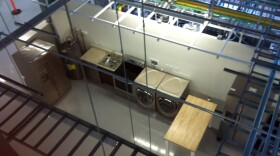The costs of wind and solar power have fallen dramatically in recent years. Still, renewables only account for a fraction of the energy produced in the United States.
That's one of the challenges facing the new director of the National Renewable Energy Lab in Golden, Colorado. Dr. Martin Keller, who took over following the retirement of Dan Arvizu in late 2015, describes NREL's mission -- acting as the nation's premier renewable energy research laboratory -- as one of filling in the gaps in science and technology.
Four Insights From The New Director Of NREL
More Innovation Is Needed If We Want To Get Most Of Our Electricity From Renewable Sources
Using wind energy as an example, Keller said much bigger towers and longer blades are needed to take advantage of wind resources in southern states. These towers and blades would be too large to be transported, and would thus need to be manufactured on-site.
"There is no technology out there; you cannot do this right now. This is where innovation comes in," Keller said.
Partnering With The Private Sector Is Critical
The U.S. still has a reputation as the world's innovation leader in renewables, Keller said, owing to the country's deep foundation in science through universities and the national lab system.
"Coupling this with U.S. companies gives the U.S. companies a tremendous edge," he added.
Storage And Transmission Remain The Biggest Hurdles
The sun isn't always shining and the wind isn't always blowing. This intermittency has long been a principle argument against the wider expansion of these energy sources. Despite the excitement generated by the announcement of Tesla's Powerwall, battery technology has been very slow to advance.
"There are these two elements," Keller said, "number one is storage, number two is also the distribution system."
Many of the country's best renewable resources -- like Wyoming's wind -- are located far from the largest populations, in western states like California. Working through the complex and often contentious process of stringing high voltage transmission lines hundreds of miles, across many different property designations, can take decades.
Scientists Need To Do A Better Job Explaining The Science Behind Climate Change
NREL is a federal facility, operated by the Department of Energy. Therefore, the entity receives funding from Congress, where polarized opinions on human-caused climate change are the order of the day. Keller laments that climate change is too often talked about in terms of whether someone "believes" in it or not, which he said pushes it out of the realm of science and into a sort of religion.
"We are not creating religions, we are creating science and engineering," he said. "On climate change, on the renewable side, we as scientists have to do a better job to explain what the driver is for the science and engineering that we're doing."
Inside Energy is a public media collaboration, based in Colorado, Wyoming and North Dakota, focusing on the energy industry and its impacts.







